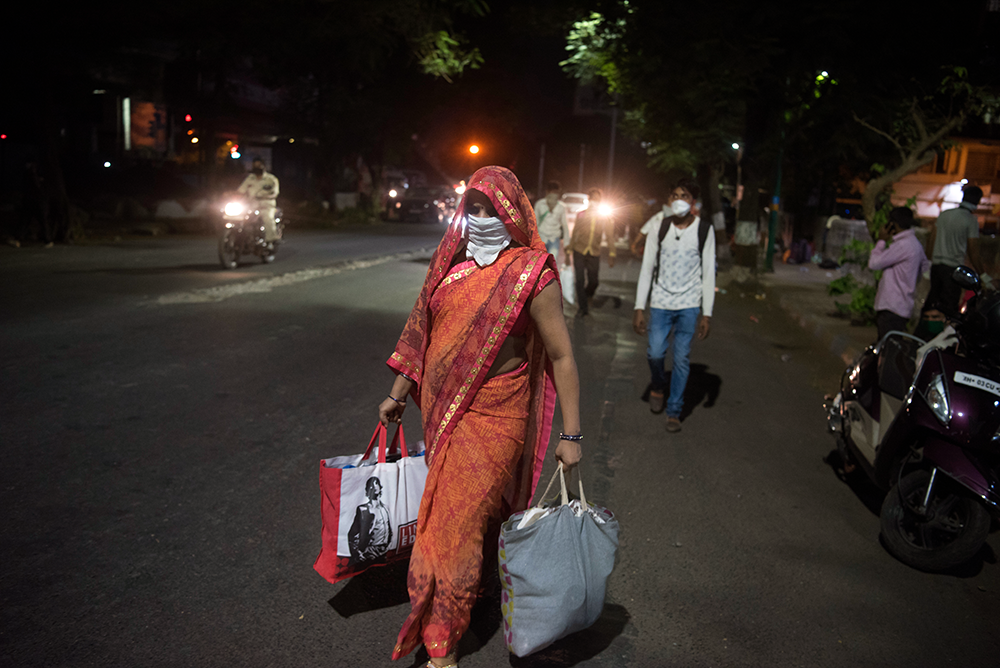Following India’s lockdown measures migrant workers, who are among the most vulnerable groups in the urban informal sector, struggle to get relief. In her contribution to our series on democratic experiences in the coronavirus pandemic, Amita Bhide, Professor and Dean of the School of Habitat Studies at TISS, Mumbai, and co-PI of the project “Mapping spaces of local democracy in India: Practices of participation in the 2014-2034 Mumbai Development Plan”, argues that “over the last two months following the decisions of lockdown and relaxations, the migrant has emerged as a figure trapped in the body politic of Indian democracy”. Professor Bhide visited the Albert Hirschman Centre on Democracy in 2018 and participated in its international conference on “Reiminaging democracy from and at the margins”.
Rukmini is 45 years old and works as a domestic worker in Mumbai. I met her late evening in Mankhurd at the highway where she, her husband and two sons had managed to reach after walking about 25 km since the morning. They were on their way to Mangaon, located more than 250 km away as they had no money left to stay in the city. ‘How can we live here without money?’ she asked me in a matter of fact manner and moved ahead at a brisk pace.
Among the many fault-lines of Indian democracy that were exposed and bared by the corona pandemic, the issue of migrants is one of the most poignant. It has meant that much more than the public health disaster, a humanitarian disaster of increasing proportions and unknown dimensions is unfolding in the country. It reflected in a large-scale crisis of hunger in several cities in the country, desperate attempts to reach home on foot or through other risky modes in a bid to escape the loss of livelihood and hunger in the city, significant losses of life in the process and occasions that provided a fertile ground for violence, rumors and a rush for accessing buses or trains risking possibilities of infection. Over the last two months following the decisions of lockdown and relaxations, the migrant has emerged as a figure trapped in the body politic of Indian democracy, denied even the choice of own mobility and the freedom to go home controlled by whims of employers, statespersons and institutions; attempting to shift the cost and responsibility from one to the other. Most critically, the migrant is also being perceived as the ‘risk’ to governmentality in the pandemic period, disrupting ideas of order and challenging capacity to discipline. The emerging relationship of the migrant to the Indian state is thus vexed; with the migrant simultaneously emerging as a ‘threat’ and ‘victim’.
The invisibility of migrants in the ‘functional’ Indian city?
Migrants are the invisible force that powers Indian cities. They work construction sites, service several people’s homes, undertake multiple forms of hazardous work such as dumping grounds, small factories or engage in own account enterprises. Their proportion in each city is not known but estimates indicate that more than 25 to 30 percent of the work force is comprised of migrants. More than 100 million migrants lead multi-local lives shuffling between villages where agriculture and local economy is unable to sustain the family for the full year and cities which use the labour but refuse to accommodate life needs and allow them to settle. The 100 million is an estimate as the circular migrant is invisible in the data systems in the country, whether the census, the national sample surveys and in systems that register labour such as state level labour. A plethora of protective legislations, and policies for food security, financial inclusion, health insurance assuming universality and portability of entitlements have been initiated in the recent past but the multi –local migrants are largely out of their net. Migrants who cross state boundaries are even more disenfranchised as several of these policies are state policies that hinge on domicile. Invisible to the state, their labour highly undervalued, most of these migrants offset the costs of city living by staying in constraining situations – locations embedding high environmental risk, housing that is congested, poorly serviced and with high levels of insecurity. There are others who are dependent on employers for shelter and for whom the entire existence in the city is mediated through the employer. There is thus a very real dysjunct between the understanding of migration at the policy level with pronouncements like ‘cities are growth engines’; being in complete opposition to the situation of migrants whom growing cities are unable to absorb.

during the nationwide lockdown as a preventive measure against COVID-19
In the wake of the lockdown…
The sudden announcement of the national lockdown on March 22nd and its extension to a period of nearly two months has resulted in a complete breakdown of the tenuous city systems which sustained the migrants. Their livelihoods came to a complete halt. Vending was disallowed. Construction work, soliciting work at labour addas (an assembly of workers at particular sites along roads) was halted. Stoppage of public transport prevented many others from going to work sites and in cases of several small to medium factories, many employers abandoned the workers. Several migrants do not have the cards that entitle them to subsidized grains from the state public distribution system; states like Maharashtra which have a large number of migrants refused to universalize the public distribution system to include the people from ‘outside’ the state. Faced with no money and no food, single migrants, families began contemplating going home. The closure of all public transport systems put an end to those hopes as well.
Families from several major cities thus began walking home. There are innumerable stories of groups of migrants walking their way over thousands of kilometres and in some cases, facing several risks while doing the same. People dying of exertion, being run over by trucks or trains; people traveling inside containers, apprehended by the police and placed in camps wherever they were caught. There have been several instances of violence and riot like situations amidst rumours of opening of buses or trains.
Those who continue to be in cities are living in great difficulty. They line up for food, more recently they line up for police permissions to leave the city, they line up in front of doctors to obtain medical certificates for the permissions to leave; they pay hard earned money or borrow money to get such certificates. The possibility of the actual safe passage home is however laden with uncertainty as states negotiate the terms, modes of such travel arrangements, lay down the costs and decide who is to bear them. In Karnataka, a decision to organize trains for migrants was revoked after a meeting with builders who suggested that this would affect the progress of projects. Madhya Pradesh and Uttar Pradesh are reforming their labour laws to make them more investor-friendly, rubbing salt over wounds.
In the mainstream discourse however, the migrant is the threat in a citizenry that is expected to acquiesce to the pandemic laws of not moving or going anywhere, social distancing and staying at home. The migrants and their actions have constantly disrupted the commands emerging from a nationalistic order since the declaration of a pandemic, exposing the fault-lines of a skin-deep democracy. The migrant thus emerges as both a victim and a threat.
Skin-Deep Democracy
This desperation, the clamour to go home, however distant; is indicative of a deep distrust of the state and city society. The migrants’ decision to tread these paths irrespective of challenges indicates that they understand that the city only has use for a productive body; it doesn’t care for them or their lives. They have not protested, nor raised demands of their elected representatives, they have no demands of the state for one has demands when there are expectations, a sense of rightfulness. Here is a set of people who know that they are stateless at the core and so have to care for self and families despite the state and its democratic rites and rituals. They only have their bodies that they can rely on and hence the departure from the city. It is in this silent act of departure that they exhibit not only their agency but also the falsity of development narratives and skin-level depth of the promises outlined in the Indian constitution committing itself to justice, liberty, equality and fraternity for all its citizens.
 Amita Bhide is Professor and Dean, School of Habitat Studies, Tata Institute of Social Sciences, Mumbai. She has been teaching and researching at the Institute for over twenty years. She has been deeply involved in issues of urban poverty, livelihoods and advocacy linked to the same in Mumbai and in other cities in India. She has contributed to social movements and to various committees of the state government on the subjects of housing and poverty. Her recent work at the School of Habitat Studies has been on urban governance reforms, housing and land issues with a focus on small and medium towns and urban violence.
Amita Bhide is Professor and Dean, School of Habitat Studies, Tata Institute of Social Sciences, Mumbai. She has been teaching and researching at the Institute for over twenty years. She has been deeply involved in issues of urban poverty, livelihoods and advocacy linked to the same in Mumbai and in other cities in India. She has contributed to social movements and to various committees of the state government on the subjects of housing and poverty. Her recent work at the School of Habitat Studies has been on urban governance reforms, housing and land issues with a focus on small and medium towns and urban violence.


